A Multi-Objective Approach to Robust Control of Air Handling Units for Optimized Energy Performance
Abstract
:1. Introduction
- 1
- A key aspect of our framework is that the multi-objective optimization is performed online, (i.e., the optimal set points are computed while considering the time-varying weather data of Auckland, New Zealand in real time during the simulations).
- 2
- To reduce the computation time per time step and to expedite the online optimization process, an approximation scheme is developed to estimate the water mass flow rate (an important variable in one of the objective functions). This reduces the complexity of the proposed framework as well.
- 3
- 4
- During the optimization process, an a posteriori approach is used to select the knee point solution from the pool of evaluated non-dominated optimal solutions. This ensures a proper balance between minimization of energy consumption and maintenance of thermal comfort.
- 5
- The uncertainty weights of the controller are estimated to reduce oscillations in the outflow air temperature of the AHU plant.
2. Dynamic Model of the AHU Plant
3. Problem Formulation
- Energy function:where is an occupant-specified parameter (to be called the energy index) which determines the amount of thermal load on the AHU plant. It is worth emphasizing here that the energy consumption of the AHU plant is determined by the thermal load, which is influenced by the difference between the outside temperature and the set-point (i.e., ). Thus, the smaller this temperature difference, the smaller the thermal load on the AHU plant is.
- Discomfort function:The corresponding comfort level is calculated as follows:For the above expression of , refer to Section 3.1. Note that the occupants’ thermal discomfort is determined by the difference between the outflow air temperature and the set point . As this temperature difference decreases, the discomfort level of the occupants decreases (i.e., the comfort level increases).
| Algorithm 1: Evaluation of objective functions at the kth time step. |
Input: Search Agent, ; Outside Weather Profile, ; Energy Index, , AHU Plant Output, Output: Objective values: and */ Outside Sensor (temperature) data 1 Collect the outside temperature value, i.e., */ Evaluate the Objective Functions */ Intuitive energy consumption level 2 */ Approximate Mass-flow Rate, 3 Calculate error (see Figure 2); */ Compute Robust Controller Output, 4 fort = to do 5 6 end 7 8 */ Approximate 9 */ Occupant discomfort level, 10 */ Normalize and between 11; |
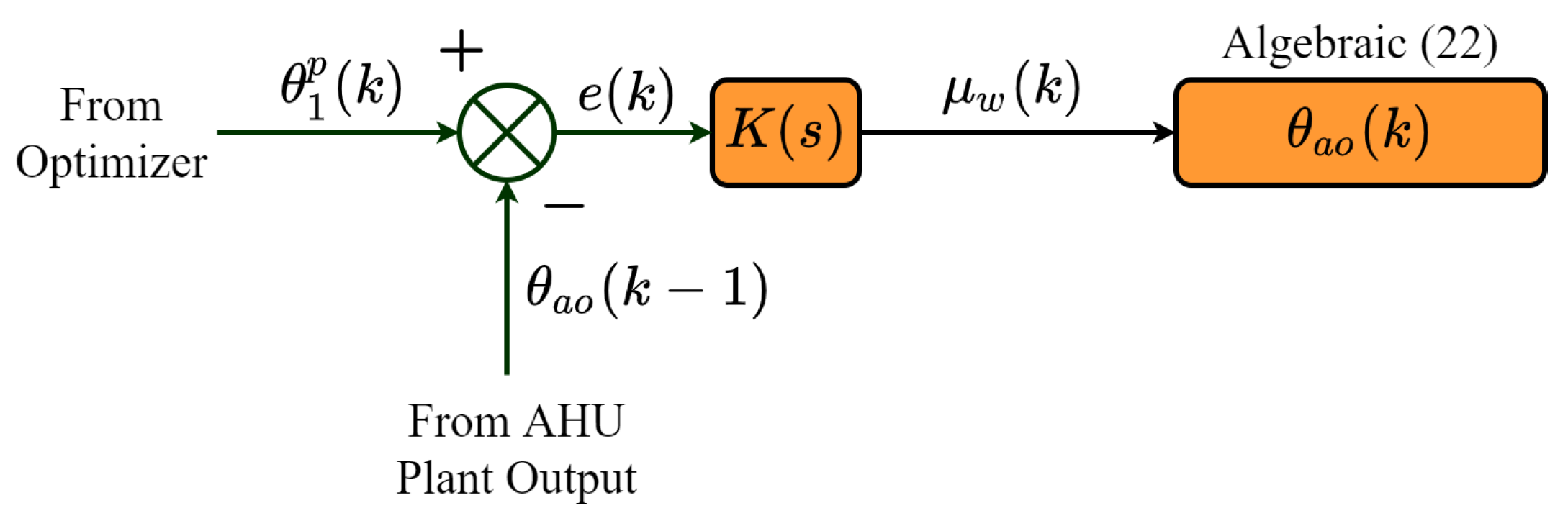
3.1. Approximation Approach to Evaluate
3.2. Search Process
| Algorithm 2: Meta-heuristic solution set selection. |
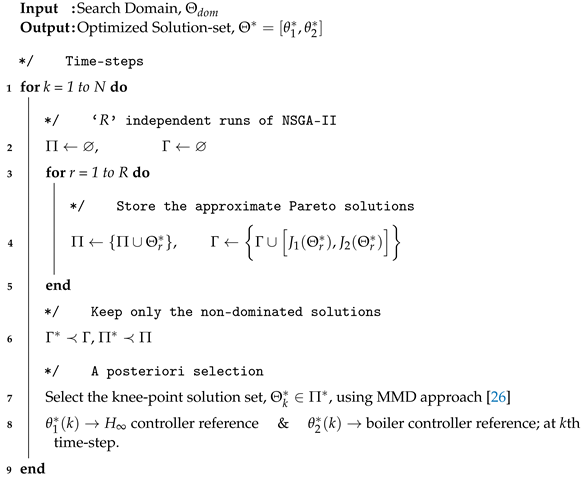 |
3.3. Best Solution Selection Process
4. Structure of the Control System
5. Simulation Results and Discussion
5.1. Simulation Set-Up
5.2. Performance Evaluation of the Controller without the Optimizer
5.3. Performance Evaluation of the Controller with the Optimizer
5.4. Computational Time Incurred by the Proposed Algorithm
5.5. Modeling Assumptions and Limitations of the Approach
6. Conclusions and Future Work
- The two controllers (with optimal set points) could significantly reduce the oscillations in the outflow air temperature compared with the conventional case, where the temperature set points were selected empirically.
- Annual energy savings of were achieved, with comfort levels maintained of the time.
- The proposed multi-objective framework is computationally effective.
Author Contributions
Funding
Data Availability Statement
Conflicts of Interest
Abbreviations
| AHU | Air handling unit |
| ASHRAE | American Society of Heating Refrigerating and Air-Conditioning Engineers |
| BEMS | Building energy management systems |
| HVAC | Heating, ventilation and air conditioning |
| HCU | Heating coil unit |
| MOOP | Multi-objective optimization problem |
| NSGA | Non-Dominated Sorting Genetic Algorithm |
| Nomenclature | |
| Symbol | |
| F | Fractional valve-stem position |
| A | Heating exchanger (coil) surface area |
| Q | Heat transfer rate |
| n | Integer number |
| g | Gain |
| Mass-flow rate | |
| Reynolds number | |
| Sensor output (feedback signal) | |
| c | Specific heat capacity |
| Temperature | |
| C | Thermal capacity |
| U | Thermal transmission coefficient |
| Time constant | |
| d | Tube diameter |
| Valve let-by | |
| Valve authority | |
| Valve installed characteristics | |
| Valve inherent characteristics | |
| Subscripts and Superscripts | |
| a | Air |
| Inflow air | |
| i | Internal |
| Outflow air | |
| Plant | |
| Inflow water | |
| Outflow water | |
| m | Heating exchanger (coil) material |
| s | Sensor (detector) |
| Tube | |
| w | Water |
| Water-design condition | |
References
- Li, D.H.; Yang, L.; Lam, J.C. Zero energy buildings and sustainable development implications–A review. Energy 2013, 54, 1–10. [Google Scholar] [CrossRef]
- Rao, D.V.; Ukil, A. Modeling of room temperature dynamics for efficient building energy management. IEEE Trans. Syst. Man Cybern. Syst. 2017, 50, 717–725. [Google Scholar] [CrossRef]
- EIA. Consumption & Efficiency. 2019. Available online: https://www.eia.gov/consumption/ (accessed on 3 September 2019).
- Brastein, O.; Perera, D.; Pfeifer, C.; Skeie, N.O. Parameter estimation for grey-box models of building thermal behaviour. Energy Build. 2018, 169, 58–68. [Google Scholar] [CrossRef] [Green Version]
- Wang, Z.; Yang, R.; Wang, L. Multi-agent control system with intelligent optimization for smart and energy-efficient buildings. In Proceedings of the IECON 2010-36th Annual Conference on IEEE Industrial Electronics Society, Glendale, AZ, USA, 7–10 November 2010; pp. 1144–1149. [Google Scholar]
- Chakraborty, N.; Mondal, A.; Mondal, S. Intelligent scheduling of thermostatic devices for efficient energy management in smart grid. IEEE Trans. Ind. Inform. 2017, 13, 2899–2910. [Google Scholar] [CrossRef]
- Dounis, A.I.; Caraiscos, C. Advanced control systems engineering for energy and comfort management in a building environment—A review. Renew. Sustain. Energy Rev. 2009, 13, 1246–1261. [Google Scholar] [CrossRef]
- Širokỳ, J.; Oldewurtel, F.; Cigler, J.; Prívara, S. Experimental analysis of model predictive control for an energy efficient building heating system. Appl. Energy 2011, 88, 3079–3087. [Google Scholar] [CrossRef]
- Wang, S.; Xu, X. Optimal and robust control of outdoor ventilation airflow rate for improving energy efficiency and IAQ. Build. Environ. 2004, 39, 763–773. [Google Scholar] [CrossRef]
- Miyata, S.; Lim, J.; Akashi, Y.; Kuwahara, Y. Optimal set-point regulation in HVAC system for controllability and energy efficiency. Adv. Build. Energy Res. 2020, 14, 160–170. [Google Scholar] [CrossRef]
- Underwood, C. Robust control of HVAC plant II: Controller design. Build. Serv. Eng. Res. Technol. 2000, 21, 63–71. [Google Scholar] [CrossRef]
- Anderson, M.; Buehner, M.; Young, P.; Hittle, D.; Anderson, C.; Tu, J.; Hodgson, D. MIMO robust control for HVAC systems. IEEE Trans. Control Syst. Technol. 2008, 16, 475–483. [Google Scholar] [CrossRef]
- Moradi, H.; Bakhtiari-Nejad, F.; Saffar-Avval, M. Multivariable robust control of an air-handling unit: A comparison between pole-placement and H∞ controllers. Energy Convers. Manag. 2012, 55, 136–148. [Google Scholar] [CrossRef]
- Mariano-Hernández, D.; Hernández-Callejo, L.; Zorita-Lamadrid, A.; Duque-Pérez, O.; García, F.S. A review of strategies for building energy management system: Model predictive control, demand side management, optimization, and fault detect & diagnosis. J. Build. Eng. 2021, 33, 101692. [Google Scholar]
- Mansy, H.; Kwon, S. Optimal HVAC Control for Demand Response via Chance-Constrained Two-Stage Stochastic Program. IEEE Trans. Smart Grid 2020, 12, 2188–2200. [Google Scholar] [CrossRef]
- Yu, L.; Jiang, T.; Zou, Y. Online energy management for a sustainable smart home with an HVAC load and random occupancy. IEEE Trans. Smart Grid 2017, 10, 1646–1659. [Google Scholar] [CrossRef] [Green Version]
- Ma, K.; Hu, G.; Spanos, C.J. Energy management considering load operations and forecast errors with application to HVAC systems. IEEE Trans. Smart Grid 2016, 9, 605–614. [Google Scholar] [CrossRef]
- Lu, N. An evaluation of the HVAC load potential for providing load balancing service. IEEE Trans. Smart Grid 2012, 3, 1263–1270. [Google Scholar] [CrossRef]
- Jindal, A.; Kumar, N.; Rodrigues, J.J. A heuristic-based smart HVAC energy management scheme for university buildings. IEEE Trans. Ind. Inform. 2018, 14, 5074–5086. [Google Scholar] [CrossRef]
- Wang, Z.; Wang, L.; Dounis, A.I.; Yang, R. Multi-agent control system with information fusion based comfort model for smart buildings. Appl. Energy 2012, 99, 247–254. [Google Scholar] [CrossRef]
- Manic, M.; Wijayasekara, D.; Amarasinghe, K.; Rodriguez-Andina, J.J. Building energy management systems: The age of intelligent and adaptive buildings. IEEE Ind. Electron. Mag. 2016, 10, 25–39. [Google Scholar] [CrossRef]
- Tsui, K.M.; Chan, S.C. Demand response optimization for smart home scheduling under real-time pricing. IEEE Trans. Smart Grid 2012, 3, 1812–1821. [Google Scholar] [CrossRef]
- Rezaei, E.; Dagdougui, H. Optimal real-time energy management in apartment building integrating microgrid with multi-zone HVAC control. IEEE Trans. Ind. Inform. 2020, 16, 6848–6856. [Google Scholar] [CrossRef]
- Shakouri, H.; Kazemi, A. Multi-objective cost-load optimization for demand side management of a residential area in smart grids. Sustain. Cities Soc. 2017, 32, 171–180. [Google Scholar] [CrossRef]
- Li, D.; Chiu, W.Y.; Sun, H.; Poor, H.V. Multiobjective optimization for demand side management program in smart grid. IEEE Trans. Ind. Inform. 2017, 14, 1482–1490. [Google Scholar] [CrossRef] [Green Version]
- Chiu, W.Y.; Yen, G.G.; Juan, T.K. Minimum Manhattan distance approach to multiple criteria decision making in multi-objective optimization problems. IEEE Trans. Evol. Comput. 2016, 20, 972–985. [Google Scholar] [CrossRef] [Green Version]
- Hafiz, F.; Swain, A.; Mendes, E.M.A.M.; Aguirre, L.A. MultiObjective Evolutionary Approach to Grey-Box Identification of Buck Converter. IEEE Trans. Circuits Syst. I Regul. Pap. 2020, 67, 2016–2028. [Google Scholar] [CrossRef] [Green Version]
- Hafiz, F.; Swain, A.; Mendes, E. Multi-objective evolutionary framework for non-linear system identification: A comprehensive investigation. Neurocomputing 2020, 386, 257–280. [Google Scholar] [CrossRef] [Green Version]
- Underwood, C. Robust control of HVAC plant I: Modelling. Build. Serv. Eng. Res. Technol. 2000, 21, 53–61. [Google Scholar] [CrossRef]
- Zajic, I.; Larkowski, T.; Sumislawska, M.; Burnham, K.J.; Hill, D. Modelling of an air handling unit: A Hammerstein-bilinear model identification approach. In Proceedings of the 2011 21st International Conference on Systems Engineering, Washington, DC, USA, 16–18 August 2011; pp. 59–63. [Google Scholar]
- Deb, K. Multi-objective optimisation using evolutionary algorithms: An introduction. In Multi-Objective Evolutionary Optimisation for Product Design and Manufacturing; Springer: Berlin/Heidelberg, Germany, 2011; pp. 3–34. [Google Scholar]
- Deb, K.; Pratap, A.; Agarwal, S.; Meyarivan, T. A fast and elitist multiobjective genetic algorithm: NSGA-II. IEEE Trans. Evol. Comput. 2002, 6, 182–197. [Google Scholar] [CrossRef] [Green Version]
- Pang, L.M.; Ishibuchi, H.; Shang, K. NSGA-II with simple modification works well on a wide variety of many-objective problems. IEEE Access 2020, 8, 190240–190250. [Google Scholar] [CrossRef]
- Jain, A.; Lalwani, S.; Lalwani, M. A comparative analysis of MOPSO, NSGA-II, SPEA2 and PESA2 for multi-objective optimal power flow. In Proceedings of the 2018 2nd International Conference on Power, Energy and Environment: Towards Smart Technology (ICEPE), Shillong, India, 1–2 June 2018; pp. 1–6. [Google Scholar]
- National Institute of Water and Atmospheric Research Limited (NIWA). Weather and Climate Forecasting Services, Auckland, New Zealand. 2021. Available online: https://niwa.co.nz/our-services/online-services/environmental-data-explorer-new-zealand (accessed on 25 December 2022).
- ASHRAE. ASHRAE STANDARD: Thermal Environmental Conditions for Human Occupancy; ASHRAE: Peachtree Corners, GA, USA, 2016; ISSN 1041-2336. [Google Scholar]
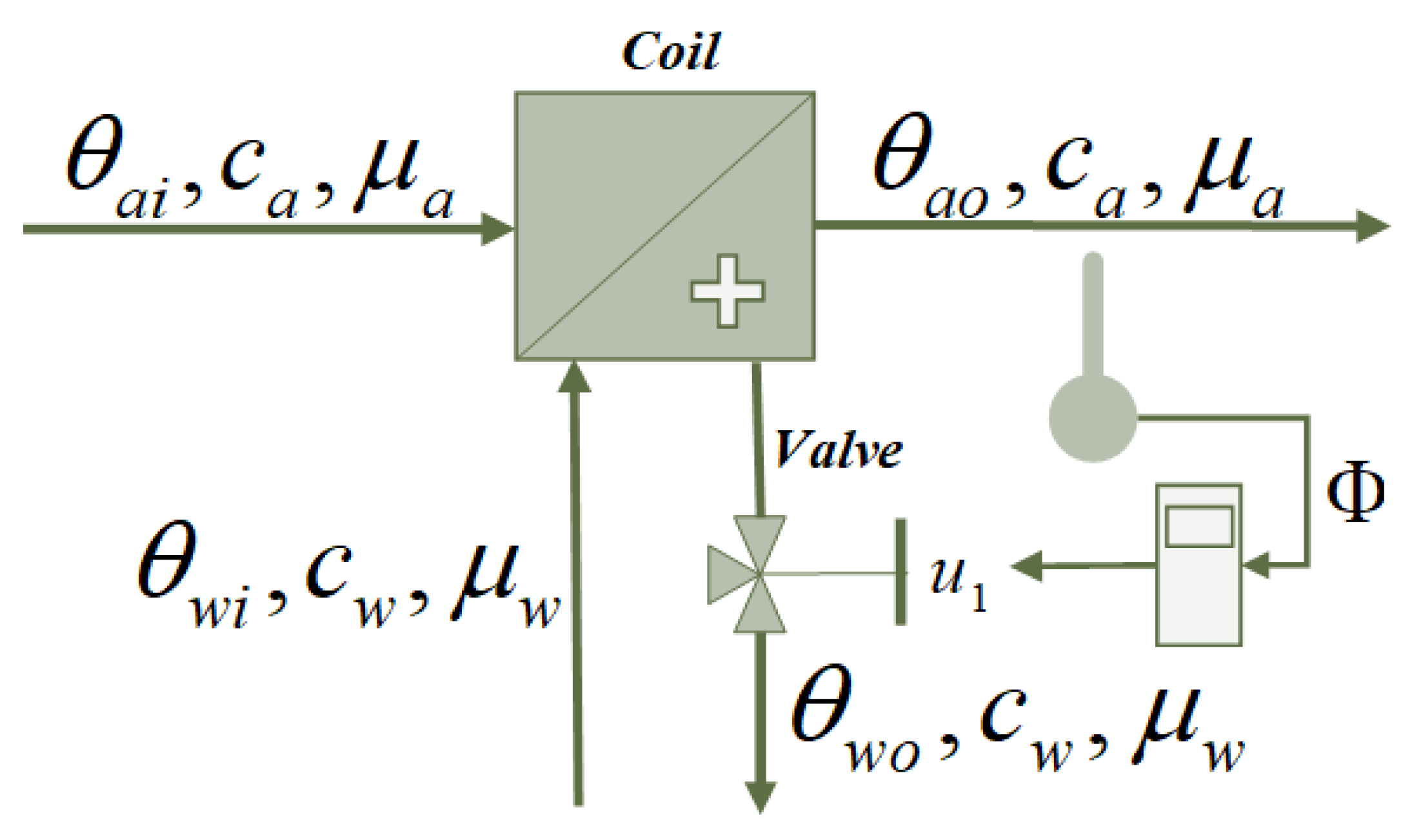
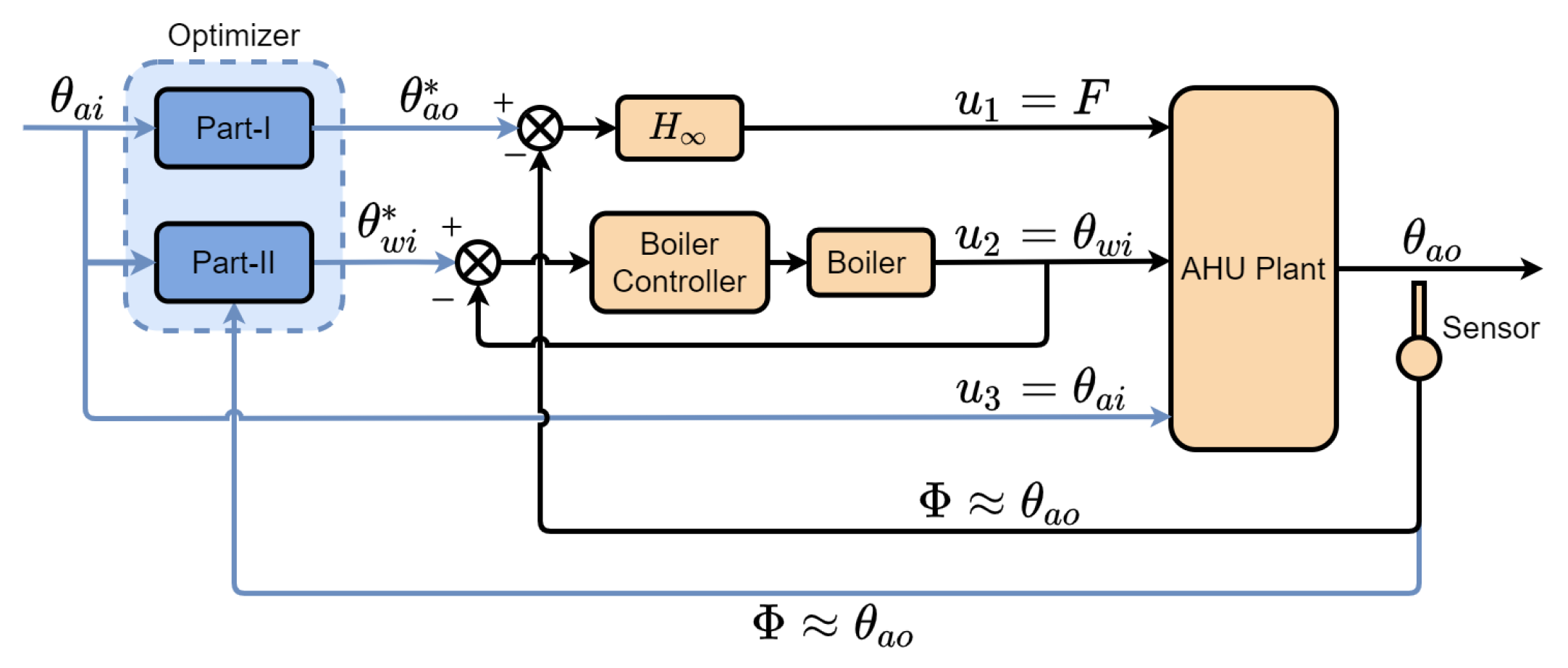
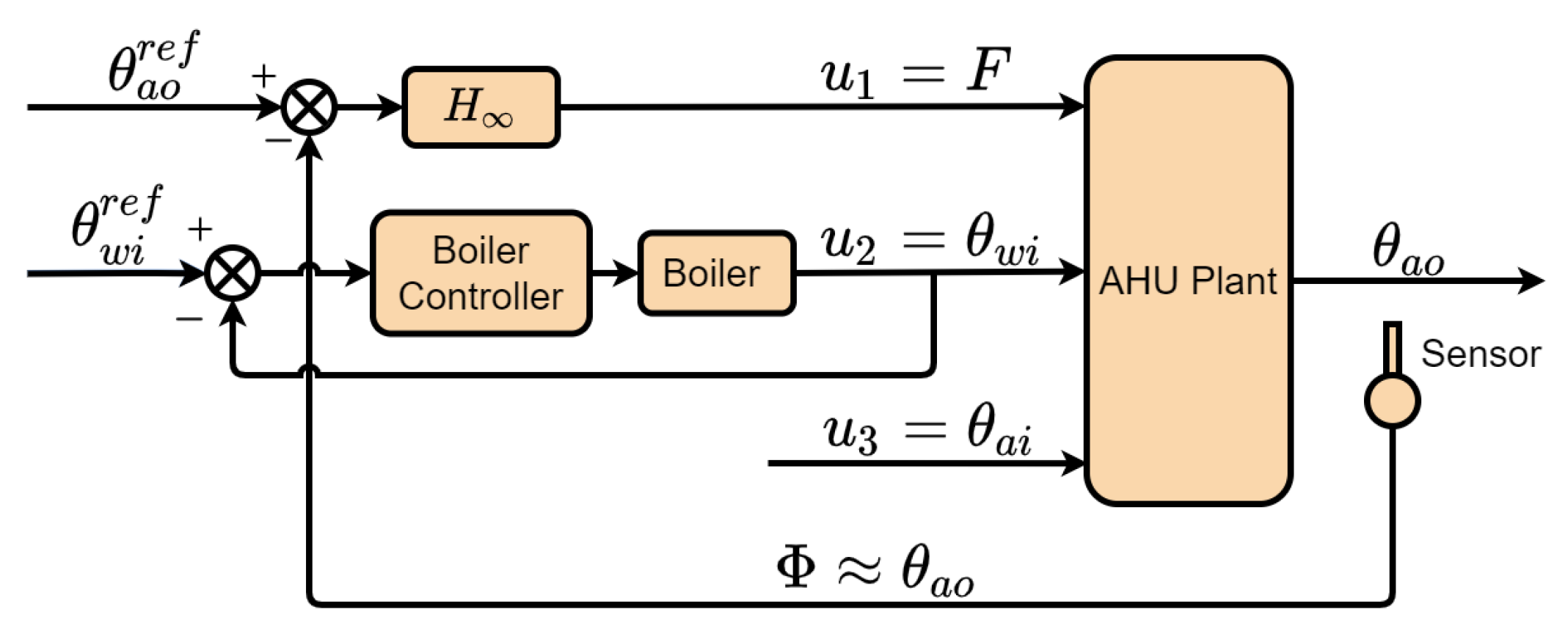








| Decision Variable | Search Domain () | |
|---|---|---|
| (°C) | 19 | 25 |
| (°C) | 10 | 40 |
| Time Duration (t) | Energy Consumption (kWh) | Energy Saving (kWh) | |
|---|---|---|---|
| Without Optimizer () | With Optimizer () | ||
| First Day of January (24 h) | |||
| First Day of June (24 h) | |||
| Entire Year (8640 h) | |||
| Time Duration (N) | Number of Time Steps with Comfort Levels | Increase in Comfort Levels (%) | |
|---|---|---|---|
| Without Optimizer | With Optimizer | ||
| First Day of January (144 time steps) | 89 | 136 | |
| First Day of June (144 time steps) | 26 | 91 | |
| Entire Year (51,840 time steps) | |||
Disclaimer/Publisher’s Note: The statements, opinions and data contained in all publications are solely those of the individual author(s) and contributor(s) and not of MDPI and/or the editor(s). MDPI and/or the editor(s) disclaim responsibility for any injury to people or property resulting from any ideas, methods, instructions or products referred to in the content. |
© 2023 by the authors. Licensee MDPI, Basel, Switzerland. This article is an open access article distributed under the terms and conditions of the Creative Commons Attribution (CC BY) license (https://creativecommons.org/licenses/by/4.0/).
Share and Cite
Wani, M.; Hafiz, F.; Swain, A.; Ukil, A. A Multi-Objective Approach to Robust Control of Air Handling Units for Optimized Energy Performance. Electronics 2023, 12, 661. https://doi.org/10.3390/electronics12030661
Wani M, Hafiz F, Swain A, Ukil A. A Multi-Objective Approach to Robust Control of Air Handling Units for Optimized Energy Performance. Electronics. 2023; 12(3):661. https://doi.org/10.3390/electronics12030661
Chicago/Turabian StyleWani, Mubashir, Faizal Hafiz, Akshya Swain, and Abhisek Ukil. 2023. "A Multi-Objective Approach to Robust Control of Air Handling Units for Optimized Energy Performance" Electronics 12, no. 3: 661. https://doi.org/10.3390/electronics12030661





